
Hãy nhập câu hỏi của bạn vào đây, nếu là tài khoản VIP, bạn sẽ được ưu tiên trả lời.


ĐKXĐ: \(x+2y\ne0\)
\(\left\{{}\begin{matrix}x-\dfrac{1}{x+2y}=\dfrac{7}{4}\\-\dfrac{5}{2}x+2+\dfrac{4}{x+2y}=-2\end{matrix}\right.\)
Đặt \(\dfrac{1}{x+2y}=z\) ta được hệ:
\(\left\{{}\begin{matrix}x-z=\dfrac{7}{4}\\-\dfrac{5}{2}x+4z=-4\end{matrix}\right.\) \(\Rightarrow\left\{{}\begin{matrix}x=2\\z=\dfrac{1}{4}\end{matrix}\right.\)
\(\Rightarrow\left\{{}\begin{matrix}x=2\\\dfrac{1}{x+2y}=\dfrac{1}{4}\end{matrix}\right.\) \(\Rightarrow\left\{{}\begin{matrix}x=2\\x+2y=4\end{matrix}\right.\)
\(\Rightarrow\left\{{}\begin{matrix}x=2\\y=1\end{matrix}\right.\)

Gọi số xe dự định tham gia chở hàng là x (xe) với x>4, x nguyên dương
Mỗi xe dự định chở khối lượng hàng là: \(\dfrac{20}{x}\) (tấn)
Số xe thực tế tham gia chở hàng là: \(x-4\) (xe)
Thực tế mỗi xe phải chở số hàng là: \(\dfrac{20}{x-4}\) (tấn)
Do thực tế mỗi xe phải chở nhiều hơn dự định là 5/6 tấn hàng nên ta có pt:
\(\dfrac{20}{x-4}-\dfrac{20}{x}=\dfrac{5}{6}\)
\(\Rightarrow24x-24\left(x-4\right)=x\left(x-4\right)\)
\(\Leftrightarrow x^2-4x-96=0\)
\(\Rightarrow\left[{}\begin{matrix}x=12\\x=-8\left(loại\right)\end{matrix}\right.\)
Vậy thực tế có \(12-4=8\) xe tham gia vận chuyển

M A O B E F H K P Q
a/
Ta có
AE = HE; BF = HF (2 tiếp tuyến cùng xp từ 1 điểm ngoài hình tròn thì khoảng cách từ điểm đó đến 2 tiếp điểm bằng nhau)
=> AE + BF = HE + HF = EF (dpcm)
b/ Gọi P; K; Q lần lượt là giao của OE; OM; OF với (O)
Ta có
sđ cung PA = sđ cung PH (Hai tiếp tuyến cùng xp từ 1 điểm ngoài hình tròn thì đường nối điểm đó với tâm chia đôi cung chắn bởi 2 tiếp điểm)
sđ cung QB = sđ cung QH (lý do như trên)
=> sđ cung PH + sđ cung QH = sđ cung PA + sđ cung QB
=> sđ cung APH = sđ cung BQH
Mà sđ cung APH + sđ cung BQH = sđ cung AKB
=> sđ cung APH = sđ cung BQH = \(\dfrac{sđcungAKB}{2}\) (1)
Ta có
sđ cung KA = sđ cung KB (Hai tiếp tuyến cùng xp từ 1 điểm ngoài hình tròn thì đường nối điểm đó với tâm chia đôi cung chắn bởi 2 tiếp điểm)
Mà sđ cung KA + sđ cung KB = sđ cung AKB
=> sđ cung KA = sđ cung KB = \(\dfrac{sđcungAKB}{2}\) (2)
Ta có
\(sđ\widehat{MOA}=sđcungKA=\dfrac{sđcungAKB}{2}\) (góc ở tâm đường tròn) (3)
\(sđ\widehat{FOE}=sđcungPHQ=sđcungPH+sđcungQH=\dfrac{sđcungAKB}{2}\) (góc ở tâm đường tròn) (4)
Từ (1) (2) (3) (4) \(\Rightarrow\widehat{MOA}=\widehat{FOE}\)

b) \(\sqrt{x^2}=\left|-8\right|\)
\(\Rightarrow\left|x\right|=8\)
\(\Rightarrow\left[{}\begin{matrix}x=8\\x=-8\end{matrix}\right.\)
d) \(\sqrt{9x^2}=\left|-12\right|\)
\(\Rightarrow\sqrt{\left(3x\right)^2}=12\)
\(\Rightarrow\left|3x\right|=12\)
\(\Rightarrow\left[{}\begin{matrix}3x=12\\3x=-12\end{matrix}\right.\)
\(\Rightarrow\left[{}\begin{matrix}x=\dfrac{12}{3}\\x=-\dfrac{12}{3}\end{matrix}\right.\)
\(\Rightarrow\left[{}\begin{matrix}x=4\\x=-4\end{matrix}\right.\)

ĐKXĐ: \(\left\{{}\begin{matrix}2x-3>=0\\x+1>=0\end{matrix}\right.\)
=>\(\left\{{}\begin{matrix}x>=\dfrac{3}{2}\\x>=-1\end{matrix}\right.\)
=>\(x>=\dfrac{3}{2}\)
\(\sqrt{2x-3}-\sqrt{x+1}=x-4\)
=>\(\dfrac{2x-3-x-1}{\sqrt{2x-3}+\sqrt{x+1}}-\left(x-4\right)=0\)
=>\(\left(x-4\right)\left(\dfrac{1}{\sqrt{2x-3}+\sqrt{x+1}}-1\right)=0\)
=>x-4=0
=>x=4(nhận)

\(x^2+3x+2+2\left(2-x\right)\sqrt{x-1}=0\left(x\ge1\right)\)
\(\Leftrightarrow x^2-x-2x+2-2\left(x-2\right)\sqrt{x-1}=0\)
\(\Leftrightarrow x\left(x-1\right)-2\left(x-1\right)-2\left(x-2\right)\sqrt{x-1}=0\)
\(\Leftrightarrow\left(x-1\right)\left(x-2\right)-2\left(x-2\right)\sqrt{x-1}=0\)
\(\Leftrightarrow\left(x-2\right)\sqrt{x-1}\left(\sqrt{x-1}-2\right)=0\)
\(\Leftrightarrow\left[{}\begin{matrix}x-2=0\\\sqrt{x-1}=0\\\sqrt{x-1}-2=0\end{matrix}\right.\)
\(\Leftrightarrow\left[{}\begin{matrix}x=2\left(tm\right)\\x-1=0\\\sqrt{x-1}=2\end{matrix}\right.\)
\(\Leftrightarrow\left[{}\begin{matrix}x=2\left(tm\right)\\x=1\left(tm\right)\\x-1=4\end{matrix}\right.\)
\(\Leftrightarrow\left[{}\begin{matrix}x=2\\x=1\\x=5\end{matrix}\right.\left(tm\right)\)
Vậy: \(x\in\left\{1;2;5\right\}\)

Mình không thấy câu nào cả thì giúp kiểu gì lỗi ảnh hay sao ý

a. Câu này đơn giản em tự giải
b.
Xét hai tam giác OIM và OHN có:
\(\left\{{}\begin{matrix}\widehat{OIM}=\widehat{OHN}=90^0\\\widehat{MON}\text{ chung}\\\end{matrix}\right.\) \(\Rightarrow\Delta OIM\sim\Delta OHN\left(g.g\right)\)
\(\Rightarrow\dfrac{OI}{OH}=\dfrac{OM}{ON}\Rightarrow OI.ON=OH.OM\)
Cũng từ 2 tam giác đồng dạng ta suy ra \(\widehat{OMI}=\widehat{ONH}\)
Tứ giác OAMI nội tiếp (I và A cùng nhìn OM dưới 1 góc vuông)
\(\Rightarrow\widehat{OAI}=\widehat{OMI}\)
\(\Rightarrow\widehat{OAI}=\widehat{ONH}\) hay \(\widehat{OAI}=\widehat{ONA}\)
c.
Xét hai tam giác OAI và ONA có:
\(\left\{{}\begin{matrix}\widehat{OAI}=\widehat{ONA}\left(cmt\right)\\\widehat{AON}\text{ chung}\end{matrix}\right.\) \(\Rightarrow\Delta OAI\sim\Delta ONA\left(g.g\right)\)
\(\Rightarrow\dfrac{OA}{ON}=\dfrac{OI}{OA}\Rightarrow OI.ON=OA^2=OC^2\) (do \(OA=OC=R\))
\(\Rightarrow\dfrac{OC}{ON}=\dfrac{OI}{OC}\)
Xét hai tam giác OCN và OIC có:
\(\left\{{}\begin{matrix}\dfrac{OC}{ON}=\dfrac{OI}{OC}\\\widehat{CON}\text{ chung}\end{matrix}\right.\) \(\Rightarrow\Delta OCN\sim\Delta OIC\left(g.g\right)\)
\(\Rightarrow\widehat{OCN}=\widehat{OIC}=90^0\) hay tam giác ACN vuông tại C
\(\widehat{ABC}\) là góc nt chắn nửa đường tròn \(\Rightarrow BC\perp AB\)
Áp dụng hệ thức lượng trong tam giác vuông ACN với đường cao BC:
\(BC^2=BN.BA=BN.2BH=2BN.BH\) (1)
O là trung điểm AC, H là trung điểm AB \(\Rightarrow OH\) là đường trung bình tam giác ABC
\(\Rightarrow OH=\dfrac{1}{2}BC\)
Xét hai tam giác OHN và EBC có:
\(\left\{{}\begin{matrix}\widehat{OHN}=\widehat{EBC}=90^0\\\widehat{ONH}=\widehat{ECB}\left(\text{cùng phụ }\widehat{IEB}\right)\end{matrix}\right.\) \(\Rightarrow\Delta OHN\sim\Delta EBC\left(g.g\right)\)
\(\Rightarrow\dfrac{OH}{EB}=\dfrac{HN}{BC}\Rightarrow HN.EB=OH.BC=\dfrac{1}{2}BC^2\)
\(\Rightarrow BC^2=2HN.EB\) (2)
(1);(2) \(\Rightarrow BN.BH=HN.BE\)
\(\Rightarrow BN.BH=\left(BN+BH\right).BE\)
\(\Rightarrow\dfrac{1}{BE}=\dfrac{BN+BH}{BN.BH}=\dfrac{1}{BH}+\dfrac{1}{BN}\) (đpcm)
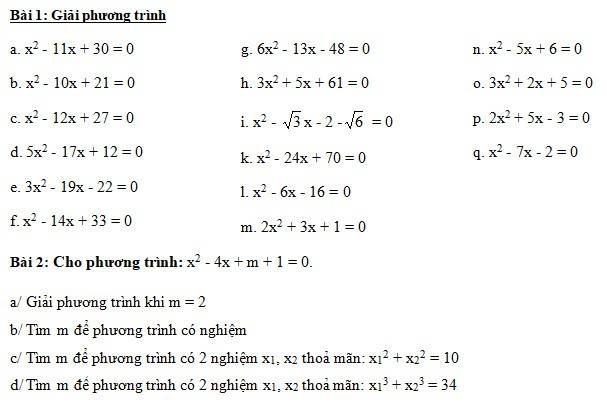
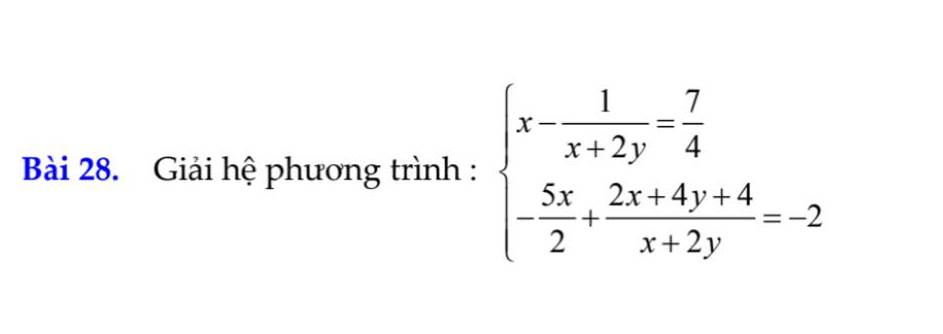




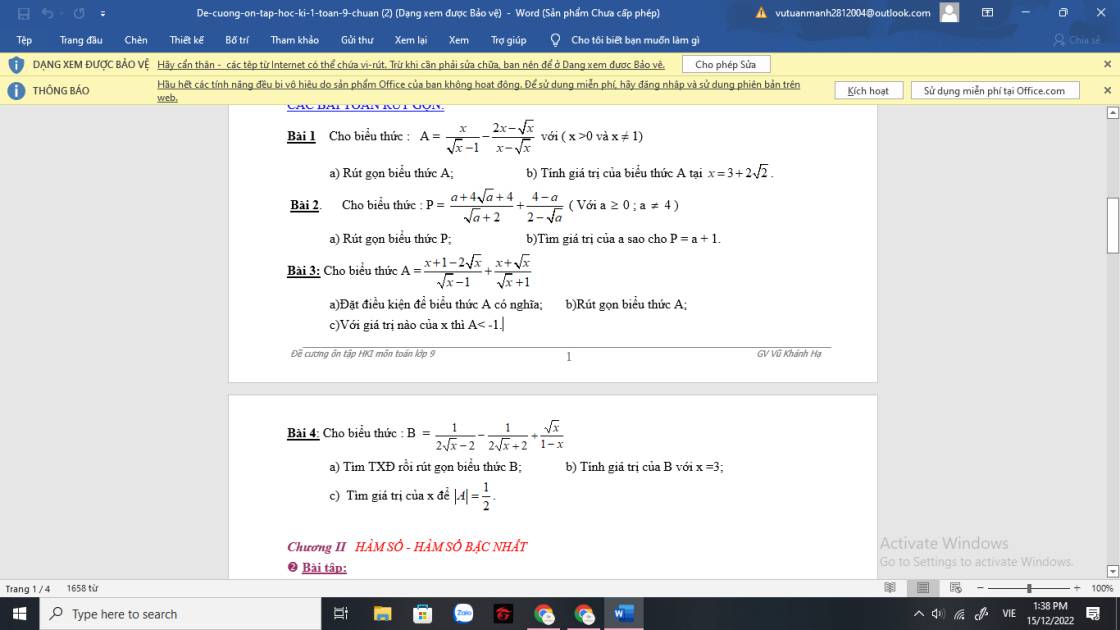
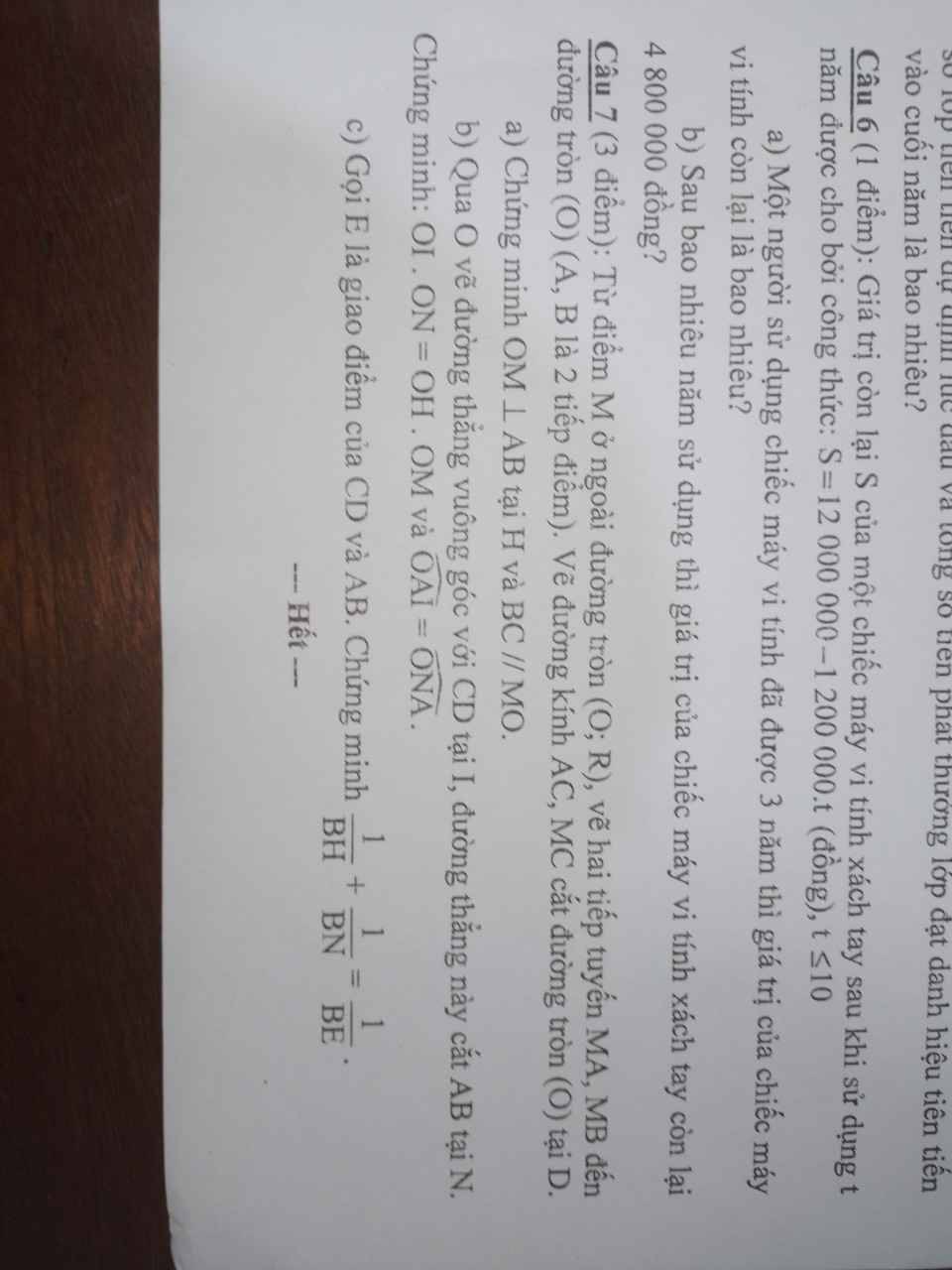
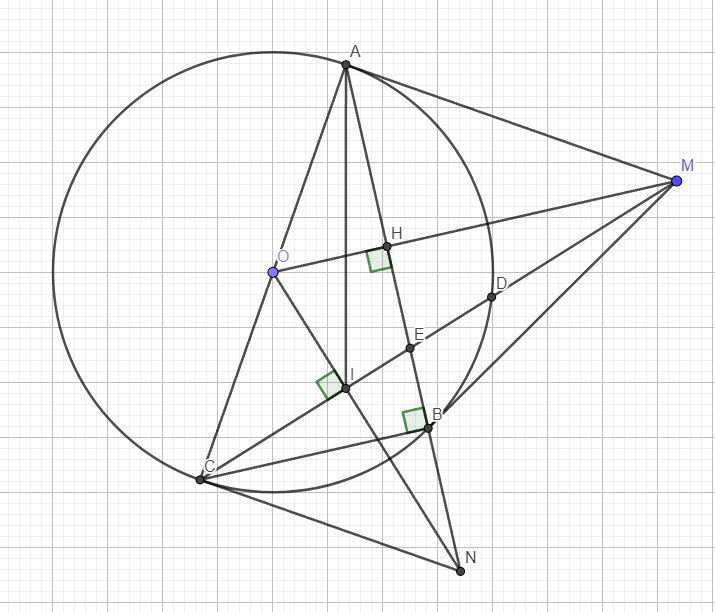
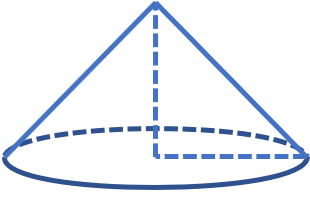
Bài 2:
a) Khi m = 2 ta có pt:
\(x^2-4x+m+1=0\)
\(\Leftrightarrow x^2-4x+3=0\)
\(\Delta=\left(-4\right)^2-4\cdot1\cdot3=4>0\)
\(\Leftrightarrow\left[{}\begin{matrix}x_1=\dfrac{4+\sqrt{4}}{2}=3\\x_2=\dfrac{4-\sqrt{4}}{2}=1\end{matrix}\right.\)
b) Để pt có nghiệm thì:
\(\Delta\ge0\)
\(\Leftrightarrow\left(-4\right)^2-4\cdot1\cdot\left(m+1\right)\ge0\)
\(\Leftrightarrow16-4m-4\ge0\)
\(\Leftrightarrow-4m+12\ge0\)
\(\Leftrightarrow4m\le12\)
\(\Leftrightarrow m\le3\)
c) \(x^2-4x+m+1=0\)
\(\Delta=\left(-4\right)^2+4\cdot1\cdot\left(m+1\right)=12-4m\)
Để pt có 2 nghiệm phân biệt thì m < 3
\(\Leftrightarrow\left[{}\begin{matrix}x_1=\dfrac{4+\sqrt{12-4m}}{2}=2+\sqrt{3-m}\\x_2=\dfrac{4-\sqrt{12-4m}}{2}=2-\sqrt{3-m}\end{matrix}\right.\)
Mà: \(x^2_1+x^2_2=10\)
\(\Leftrightarrow\left(2+\sqrt{3-m}\right)^2+\left(2-\sqrt{3-m}\right)^2=10\)
\(\Leftrightarrow4+4\sqrt{3-m}+3-m+4-4\sqrt{3-m}+3-m=10\)
\(\Leftrightarrow14-2m=10\)
\(\Leftrightarrow2m=4\)
\(\Leftrightarrow m=2\left(tm\right)\)
d) Ta có: \(x^3_1+x^3_2=34\)
\(\Leftrightarrow\left(2+\sqrt{3-m}\right)^2+\left(2-\sqrt{3-m}\right)^2=34\)
\(\Leftrightarrow8+12\sqrt{3-m}+6\left(3-m\right)+\left(3-m\right)\sqrt{3-m}+8-12\sqrt{3-m}+6\left(3-m\right)-\left(3-m\right)\sqrt{3-m}=34\)
\(\Leftrightarrow16+12\left(3-m\right)=34\)
\(\Leftrightarrow2\left(3-m\right)=18\)
\(\Leftrightarrow3-m=9\)
\(\Leftrightarrow m=-6\left(tm\right)\)
Bài 1:
a: \(x^2-11x+30=0\)
=>\(x^2-5x-6x+30=0\)
=>\(x\left(x-5\right)-6\left(x-5\right)=0\)
=>(x-5)(x-6)=0
=>\(\left[{}\begin{matrix}x-5=0\\x-6=0\end{matrix}\right.\Leftrightarrow\left[{}\begin{matrix}x=5\\x=6\end{matrix}\right.\)
b: \(x^2-10x+21=0\)
=>\(x^2-3x-7x+21=0\)
=>\(x\left(x-3\right)-7\left(x-3\right)=0\)
=>\(\left(x-3\right)\left(x-7\right)=0\)
=>\(\left[{}\begin{matrix}x-3=0\\x-7=0\end{matrix}\right.\Leftrightarrow\left[{}\begin{matrix}x=3\\x=7\end{matrix}\right.\)
c: \(x^2-12x+27=0\)
=>\(x^2-3x-9x+27=0\)
=>\(x\left(x-3\right)-9\left(x-3\right)=0\)
=>\(\left(x-3\right)\left(x-9\right)=0\)
=>\(\left[{}\begin{matrix}x-3=0\\x-9=0\end{matrix}\right.\Leftrightarrow\left[{}\begin{matrix}x=3\\x=9\end{matrix}\right.\)
d: \(5x^2-17x+12=0\)
=>\(5x^2-5x-12x+12=0\)
=>\(5x\left(x-1\right)-12\left(x-1\right)=0\)
=>(x-1)(5x-12)=0
=>\(\left[{}\begin{matrix}x-1=0\\5x-12=0\end{matrix}\right.\Leftrightarrow\left[{}\begin{matrix}x=1\\x=\dfrac{12}{5}\end{matrix}\right.\)
e: \(3x^2-19x-22=0\)
=>\(3x^2-22x+3x-22=0\)
=>\(x\left(3x-22\right)+\left(3x-22\right)=0\)
=>(3x-22)(x+1)=0
=>\(\left[{}\begin{matrix}3x-22=0\\x+1=0\end{matrix}\right.\Leftrightarrow\left[{}\begin{matrix}x=\dfrac{22}{3}\\x=-1\end{matrix}\right.\)
f: \(x^2-14x+33=0\)
=>\(x^2-3x-11x+33=0\)
=>\(x\left(x-3\right)-11\left(x-3\right)=0\)
=>(x-3)(x-11)=0
=>\(\left[{}\begin{matrix}x-3=0\\x-11=0\end{matrix}\right.\Leftrightarrow\left[{}\begin{matrix}x=3\\x=11\end{matrix}\right.\)
g: \(6x^2-13x-48=0\)
\(\text{Δ}=\left(-13\right)^2-4\cdot6\cdot\left(-48\right)=1321\)
Vì Δ>0 nên phương trình có hai nghiệm phân biệt là:
\(\left\{{}\begin{matrix}x_1=\dfrac{13-\sqrt{1321}}{12}\\x_2=\dfrac{13+\sqrt{1321}}{12}\end{matrix}\right.\)
h: \(3x^2+5x+61=0\)
\(\text{Δ}=5^2-4\cdot3\cdot61=25-732=-707< 0\)
=>phương trình vô nghiệm
i: \(x^2-\sqrt{3}x-2-\sqrt{6}=0\)
=>\(\left(x^2-2\right)-\sqrt{3}\left(x+\sqrt{2}\right)=0\)
=>\(\left(x-\sqrt{2}\right)\left(x+\sqrt{2}\right)-\sqrt{3}\left(x+\sqrt{2}\right)=0\)
=>\(\left(x+\sqrt{2}\right)\left(x-\sqrt{2}-\sqrt{3}\right)=0\)
=>\(\left[{}\begin{matrix}x+\sqrt{2}=0\\x-\sqrt{2}-\sqrt{3}=0\end{matrix}\right.\Leftrightarrow\left[{}\begin{matrix}x=-\sqrt{2}\\x=\sqrt{2}+\sqrt{3}\end{matrix}\right.\)